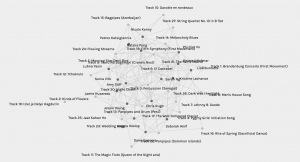
Reflection
I found our class network database from the Golden Record curation to be very interesting, though very challenging to interpret. It is compelling to see the common connections and to ponder why those connections exist without expressly seeing the reasoning behind each choice as it was made by each individual within the group. It would be possible to extrapolate reasoning for each choice by visiting the blogs of each of my classmates, reading their thought processes for curation and drawing conclusions from there, though this would be a slow and arduous process. Alternatively, I could scroll through the entire contents of each of my classmates’ blogs to interpret their ages, races, genders, cultures, orientations etc. in order to understand more about who they are as people in order to gain some understanding as to why they made the connections they did. This would be similar to what a search engine does, linking individuals in a demographic group together in the understanding that their behaviours will be similar; i.e. they may have selected the same songs. This would, of course only lead to results that assume the reasons by which groups of people selected similar results. It might also lead to misinterpretations for why they chose similar results.
The more complex question is considering what information we can infer about what is missing from the network database, i.e. reasons that certain pieces were not selected by the collective, or by individuals or groups. In the Palladio graph, what stood out to me most were the songs that people had not chosen, and I was left wondering how that might be that out of the whole group, either no one had chosen them, or only one or two people. In order to figure out why this might be, I could go through the same process as above, inferring why people did NOT make selections by analyzing choices for the songs that were included. But again, this would be speculatory. I think that ultimately it is certainly more difficult to create links and conclusions as to what is missing from the bigger picture, than to analyze what has been included.
This has ultimately led me to reflect upon the power of network connections. Much of what we come across on the web or in our personal lives, is a reflection of degrees of connectivity. We see or hear information that is ‘more connected’, and this has a high potential of impacting the way we think about the world around us. This connects to the idea from last week that information that is selected to be digitized can and has taken precedence over other content. This is ultimately why search engines like page rank are so influential; it cannot be ignored that companies like Google are influenced by wealthy and powerful corporations to prioritize certain information, giving certain kinds of information a higher degree of connectivity while leaving less connected perspectives behind.
The information that is obvious to us in the class network database is a result of the question that has been asked by the man in charge. There is plenty of other information also included in the resulting graph, but it is up to us to ask and interpret what is missing. This applies equally to all of the information that we come across on the web and in our personal lives. We need to ask what the information is telling us, but also what it is not
References
Palladio. (n.d.). Retrieved March 11, 2023, from https://hdlab.stanford.edu/palladio-app/#/upload
Systems Innovation. (2015, April 19). Network connections [Video]. YouTube.
